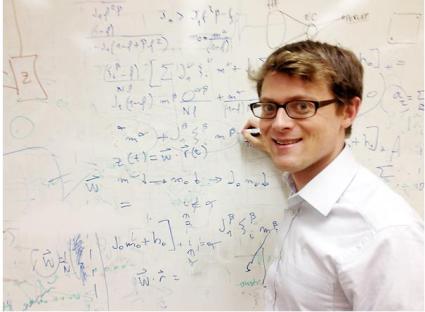Creative Minds: Meet a Theoretical Neuroscientist
Most neuroscientists make their discoveries in a traditional laboratory or clinical setting. Sean Escola, a theoretical neuroscientist at Columbia University in New York, just needs a powerful computer and, judging from his photo, a good whiteboard.
Using data that he and his colleagues have recorded from living brain cells, called neurons, Escola crunches numbers to develop rigorous statistical models that simulate the activity of neuronal circuits within the brain. He hopes his models will help to build a new neuroscience that brings into sharper focus how the brain’s biocircuitry lights up to generate sensations and thoughts—and how it misfires in various neurological disorders, particularly in mental illnesses.
Like many of his fellow neuroscientists, Escola views the brain as a complex computational machine, with the operative word being “complex.” The human brain consists of roughly 86 billion neurons and billions of other types of cells. Further complicating matters, no two neurons are exactly alike because each one reaches out and touches hundreds or thousands of other cells, forming trillions of information-processing connections, or circuits.
Throughout the day, individual circuits click on and off in our brains to process the external factors that greet and sometimes confront us. The same is true for a wide range of internal stimuli, such as a craving for food or a need for sleep. Escola wants to know how neural circuits process this interplay of internal and external signals—an area of investigation that is just becoming possible through technological innovations arising from NIH-funded research, including the pioneering Brain Research through Advancing Innovative Neurotechnologies (BRAIN) Initiative.
Supported by a 2014 NIH Director’s Early Independence Award, Escola not only will aim to gain novel insights into this interplay, but to develop innovative approaches that can be used by other researchers in their studies of neural circuitry. Through his analyses of data collected from non-human primate models, Escola will initially strive to model the neural dynamics of various brain states and then calculate normal transition times among them [1].
Escola is convinced that circuit-level theories of neural computation will transform understanding and treatment of brain disorders. This physician-scientist, who recently completed his residency in psychiatry, has even gone so far as to propose that some mental illnesses, which he dubs “transitionopathies,” may arise from a failure to transition between neural states at the appropriate times. For example, he suspects that in obsessive-compulsive disorders, a person’s brain may enter into a repetitive loop of a certain thought or behavior (such as hand washing), failing to transition normally to the next activity.
The work by Escola and other scientists to develop a comprehensive, dynamic picture of the human brain will build a knowledge base for a precise, new era of healthcare for people with mental illness and many other neurological conditions. While the first advances will likely come on the diagnostic and therapeutic fronts, our ultimate goal is to develop precise approaches for preventing this challenging, and often devastating, group of disorders.
References:
[1] Hidden Markov models for the stimulus-response relationships of multistate neural systems. Escola S, Fontanini A, Katz D, Paninski L. Neural Comput. 2011 May;23(5):1071-132.
Links:
Mental Health Information (National Institute of Mental Health/NIH)
NIH Early Independence Award Program (Common Fund)
Escola NIH Project Information (NIH RePORTER)
NIH Support: Common Fund























.png)











No hay comentarios:
Publicar un comentario